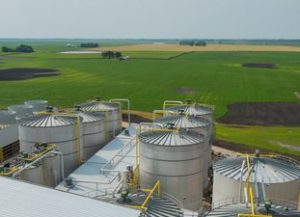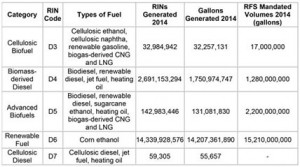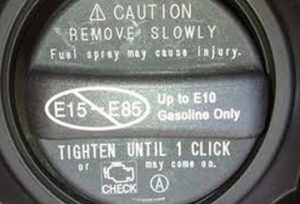 The US Environmental Protection Agency released its long-delayed Renewable Fuel Standard proposals for 2014, 2015, and 2016 on Friday. The EPA is proposing requiring 15.93 billion gallons of total renewable fuel in 2014, 16.3 billion gallons in 2015, and 17.4 billion gallons in 2016; the federal agency said the 2016 proposal is nearly 9% more — or 1.5 billion gallons — than actual 2014 volumes. The proposal is still well below the level originally mandated by Congress in the 2007 Energy Independence and Security Act – 20.5 billion gallons in 2015 and 22.25 billion gallons in 2016. The proposed rules are set to become final by late November.
The US Environmental Protection Agency released its long-delayed Renewable Fuel Standard proposals for 2014, 2015, and 2016 on Friday. The EPA is proposing requiring 15.93 billion gallons of total renewable fuel in 2014, 16.3 billion gallons in 2015, and 17.4 billion gallons in 2016; the federal agency said the 2016 proposal is nearly 9% more — or 1.5 billion gallons — than actual 2014 volumes. The proposal is still well below the level originally mandated by Congress in the 2007 Energy Independence and Security Act – 20.5 billion gallons in 2015 and 22.25 billion gallons in 2016. The proposed rules are set to become final by late November.
The EPA acknowledged that the volumes are lower than what was originally set by Congress, but will provide for steady growth over time. “In particular, the proposed volumes would ensure continued growth in advanced biofuels, which have a lower greenhouse gas emissions profile than conventional biofuels,” the EPA stated in its release. “EPA is also proposing to increase the required volume of biomass-based diesel in 2015, 2016, and 2017 while maintaining the opportunity for growth in other advanced biofuels that is needed over the long term.”
The EPA has changed course on blended biofuels, which adds ethanol to gasoline and biodiesel into diesel. According to the EPA: “Due to constraints in the fuel market to accommodate increasing volumes of ethanol, along with limits on the availability of non-ethanol renewable fuels, the volume targets specified by Congress in the Clean Air Act for 2014, 2015 and 2016 cannot be achieved. However, EPA recognizes that the statutory volume targets were intended to be ambitious; Congress set targets that envisioned growth at a pace that far exceeded historical growth rates.”
Most gasoline sold at US fuel stations contains 10% ethanol. For more ethanol to be blended in, a greater amount of fuel would need to contain gasoline with 15%, or 85% in flex-fuel vehicles. While attracting significant biofuels industry criticism on volumes, the EPA won some cautious praise for cautiously advancing renewable fuels targets for 2014 through 2016. It wasn’t right with the American Fuel and Petrochemical Manufacturers, which thinks the rule still has the EPA forcing more ethanol than the marketplace can handle.
That blend wall debate dates back to the 2005 Renewable Fuel Standard that required the blending of corn-based ethanol and other biofuels into motor fuels; it was to eventually reach 36 billion gallons in motor fuel by 2022. Based on energy independence and reducing greenhouse gas emissions, efforts by the EPA to raise the blend beyond 10% of gasoline coming from ethanol have been met with legal battles, intense lobbying, and public comment town meetings packed with supporters and opponents. Along with oil companies and refiners, automakers have backed limiting the ethanol blend with concern over potential damage to engines. Several automakers said that using E15, or anything over E10, would void their warranty coverage.




